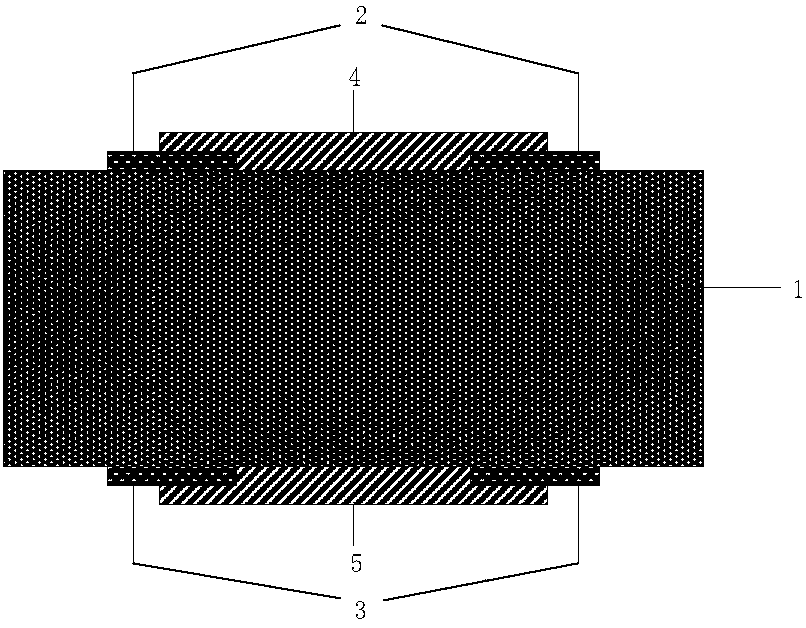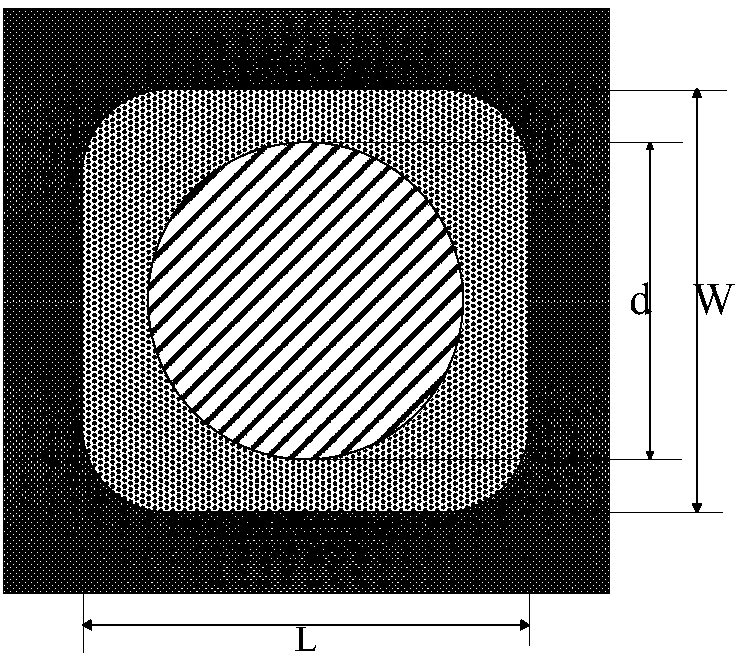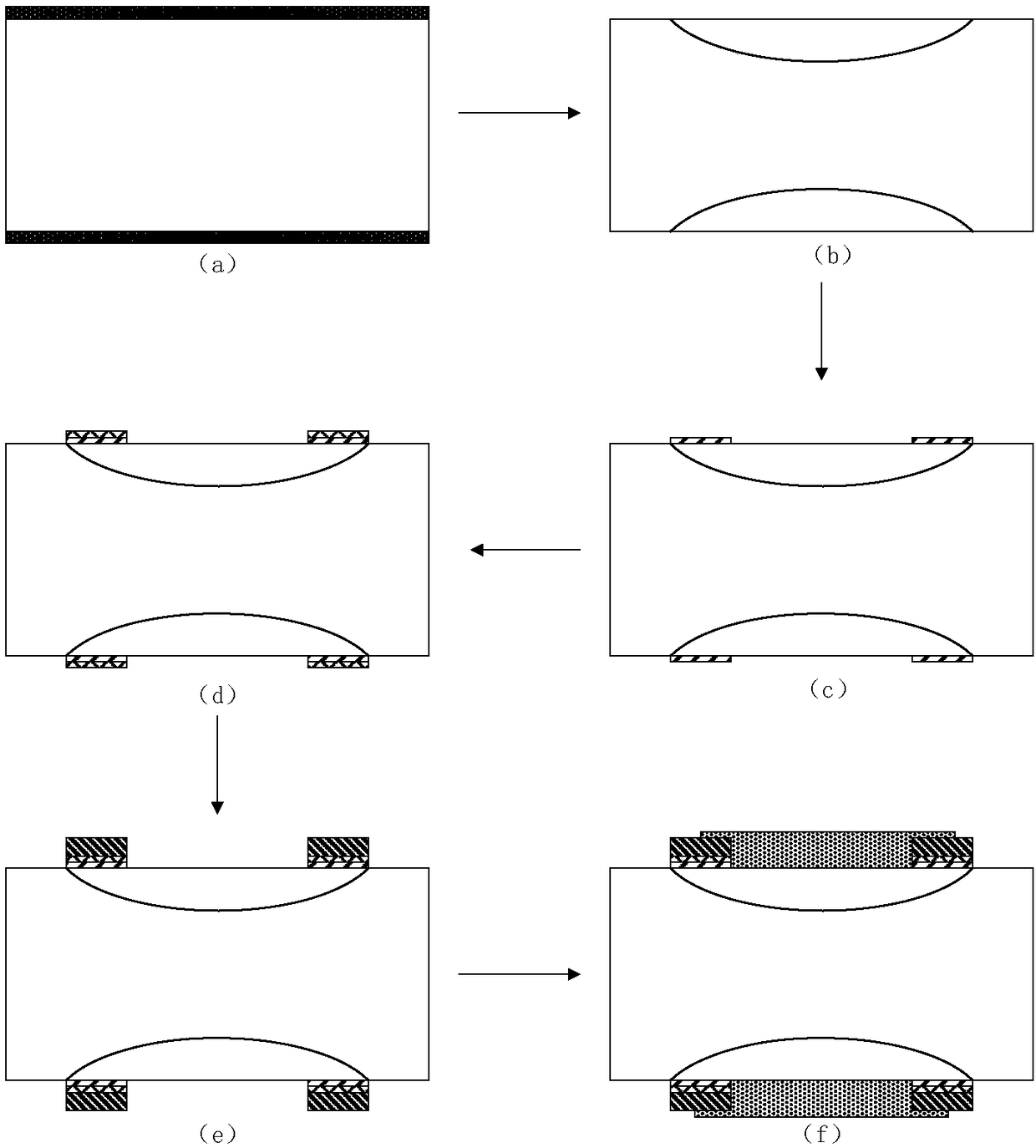Different-surface photoconductive switch based on zinc oxide transparent electrode and its manufacturing method
A transparent electrode, photoconductive switch technology, applied in the field of microelectronics, can solve the problems of inability to achieve low energy density triggering, limited laser incident area, laser energy attenuation, etc., to achieve flexible and convenient design, reduce design difficulty, and low on-resistance. Effect
- Summary
- Abstract
- Description
- Claims
- Application Information
AI Technical Summary
Problems solved by technology
Method used
Image
Examples
Embodiment 1
[0032] Example 1, making a transparent electrode different-surface photoconductive switch. The diameter d of the bottom surface of the upper film electrode and the lower film electrode is 6mm, and the thickness is 1μm.
[0033] Step 1: Deposit barrier layers on the front and back of the vanadium-doped silicon carbide substrate sample respectively.
[0034] Using the PECVD method to deposit silicon dioxide with a thickness of 2 μm on the front and back of the rectangular parallelepiped silicon carbide substrate sample, as a barrier layer for ion implantation on the front and back of the substrate; image 3 a.
[0035] Step 2: Perform ion implantation on the front and back of the sample respectively.
[0036] (2a) Apply glue on the barrier layer on the front and back of the sample respectively, etch the ion implantation window on the barrier layer after coating with a photolithography plate, and use HF acid with a concentration of 5% to etch away the barrier layer under the wi...
Embodiment 2
[0052] Example 2, making a transparent electrode different-surface photoconductive switch. The diameter d of the bottom surface of the upper film electrode and the lower film electrode is 6.5mm, and the thickness is 1.5μm. The thickness of the upper ohmic contact electrode and the lower ohmic contact electrode is 1.165μm.
[0053] Step 1: Deposit barrier layers on the front and back of the vanadium-doped silicon carbide substrate sample respectively.
[0054] Using the PECVD method to deposit silicon dioxide with a thickness of 2.5 μm on the front and back of the rectangular parallelepiped silicon carbide substrate sample, as a barrier layer for ion implantation on the front and back of the substrate; image 3 a.
[0055] Step 2: Perform ion implantation on the front and back of the sample respectively.
[0056] First, apply glue on the barrier layer on the front and back of the sample respectively, use a photolithography plate to etch the ion implantation window on the barr...
Embodiment 3
[0072] Example 3, making a transparent electrode different-surface photoconductive switch. The diameter d of the bottom surface of the upper film electrode and the lower film electrode is 7mm, and the thickness is 2μm.
[0073] Step A: Depositing the front and back of the vanadium-doped silicon carbide substrate respectively.
[0074] Using the PECVD method to deposit silicon dioxide with a thickness of 3 μm on the front and back of the rectangular parallelepiped silicon carbide substrate sample, as a barrier layer for ion implantation on the front and back of the substrate; image 3 a
[0075] Step B: performing ion implantation on the front and back of the sample respectively.
[0076] (Ba) Apply glue on the barrier layer on the front and back of the sample respectively, etch the ion implantation window on the barrier layer after coating with a photolithography plate, and etch the barrier layer under the window position with HF acid with a concentration of 5%. , and remov...
PUM
| Property | Measurement | Unit |
|---|---|---|
| thickness | aaaaa | aaaaa |
| thickness | aaaaa | aaaaa |
| diameter | aaaaa | aaaaa |
Abstract
Description
Claims
Application Information
 Login to View More
Login to View More - R&D
- Intellectual Property
- Life Sciences
- Materials
- Tech Scout
- Unparalleled Data Quality
- Higher Quality Content
- 60% Fewer Hallucinations
Browse by: Latest US Patents, China's latest patents, Technical Efficacy Thesaurus, Application Domain, Technology Topic, Popular Technical Reports.
© 2025 PatSnap. All rights reserved.Legal|Privacy policy|Modern Slavery Act Transparency Statement|Sitemap|About US| Contact US: help@patsnap.com



